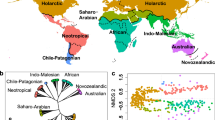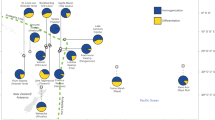Abstract
Based on comparative studies on four regional floras from northwest, west, south and southeast of Yunnan respectively, the formerly suggested two biogeographical lines, i. e. the “Tanaka Line” and the “Ecogeographical Diagonal Line”, both going from northwest to southeast of Yunnan, and their significance are discussed. In family and generic levels, similarity coefficients among the four compared floras are more than 93% and 60% separately, which indicate the close floristic affinities among them. The highest similarity coefficient, i. e. 98.7% in family level and 78.6% in generic level separately, is found between the regional flora of northwest Yunnan and the flora of southeast Yunnan although these two regions are the most distant away each other among the compared regional floras. The flora of northwest Yunnan is also the most similar to the flora of southeast Yunnan in floristic composition. These support the idea of “Ecogeographical Diagonal Line”. In specific level, the relatively high similarity coefficient is between the regional flora of west Yunnan and the one of south Yunnan. The floristic affinities among these regional floras and some distribution patterns could be explained by the geological history and tectonic theory of Yunnan.
Similar content being viewed by others
References
AUDLEY-CHARLES M G, 1987. Dispersal of Gondwanaland: Relevance to evolution of the Angiosperms[A]. In: WHITMORE T C (ed.). Biogeographical Evolution of the Malay Archipelago[C]. Oxford: Clarendon Press, 5–25.
FORTEY R A & COCKS L R M, 1998. Biogeography and palaeogeography of the Sibumasu terrene in the Ordovician: a review[A]. In: HALL R et HOLLOWAY J D (ed.). Biogeography and Geological Evolution of SE Asia[C]. Leiden: Backbuys Publishers, 43–56.
HALL R, 1998. The plate tectonics of Cenozoic SE Asia and the distribution of land and sea[A]. In: HALL R & HOLLOWAY J D (ed.). Biogeography and Geological Evolution of SE Asia [C]. Leiden: Backbuys Publishers, 99–131.
LANG Kai-yong, 1994. Studies on the distribution patterns of some significant genera in orchid flora[J]. Acta Phytotaxon. Sin.. 32: 328–339. (in Chinese)
LI Heng, 1993. Plants of Dulongjiang Region[M]. Kunming: Yunnan Science & Technology Press, 1–220. (in Chinese)
LI Heng, 1994a. Delineation and feature of Dulongjiang region flora[J]. Acta Bot. Yunn. Suppl., 6: 1–100. (in Chinese)
LI Heng, 1994b. The biological effect to the flora of Dulongjiang caused by the movement of Burma-Malaya Geoblock[J]. Acta Bot. Yunn.. Suppl., 6: 113–120. (in Chinese)
LI Heng, He Da-ming, Bartholomew B & Long Chun-lin, 1999. Re-examination of the biological effect of plate movement—impact of Shan-Malay Plate displacement (the movement of Burma-Malay Geoblock) on the biota of the Gaoligong Mountains[J]. Acta Bot. Yunn., 21 (4): 407–425.
LI Xi-wen & LI Jie, 1992. On the validity of Tanaka Line and its significance viewed from the distribution of eastern Asiatic genera in Yunnan[J]. Acta Bot. Yunn., 14 (1): 1–12. (in Chinese)
LI Xi-wen & LI Jie, 1997. The Tanaka-Kaiyong Line—an important floristic line for the study of the flora of East Asia[J]. Ann. Missouri Bot. Gard., 84: 888–892.
LU Shu-gang, ZHANG Guang-fei, 1994. A Study on the Pteridoflora from Bozhu Mountain, SE Yunnan[J]. Journ. Yunn. University (Natural Sciences), 16 (3): 276–280. (in Chinese)
METCALFE I, 1998. Paleozoic and Mesozoic geological evolution of the SE Asia region: multidisciplinary constraints and implications for biogeography[A]. In: HALL R et HOLLOWAY J D (ed.). Biogeography and Geological Evolution of SE Asia [C]. Leiden: Backbuys Publishers, 25–41.
MORLEY J R, 1998. Palynological evidence for Tertiary plant dispersal in the SE Asian region in relation to plate tectonics and climate[A]. In: HALL R et HOLLOWAY J D (ed.). Biogeography and Geological Evolution of SE Asia [C]. Leiden: Backbuys Publishers, 221–234.
SHI Ya-feng, LI Ji-yun, LI Bing-yuna et al., 1998. Uplift and environmental evolution of Qinghai-Xizang (Tibetan) Plateau [A]. In: Sun Honglie, Zheng Du (ed.). Formation, evolution and development of Qinghai-Xizang (Tibetan) Plateau [C]. Guangzhou: Guangdong Science and Technology Press, 73–138. (in Chinese).
SHI Ya-feng, LI Ji-yun, LI Bing-yuna, et al., 1999. Uplift of the Qinghai-Xizang (Tibetan) plateau and east Asia environmental change during late Cenozoic[J]. Acta Geogr. Sin., 54 (1): 10–21. (in Chinese)
TANAKA T, 1954. Species Problem in Citrus[M]. Tokyo: Japanese Society for the Promotion of Science, 58–69.
WU Te-lin, XING Fu-wu, YE Hua-gu et al., 1996. Study on the spermatophytic flora of South China Sea Islands[J]. J. Trop Subtrop Bot., 4 (1): 1–22; 4 (2): 1–11. (in Chinese)
ZHU Hua, 1994. Floristic relationships between dipterocarp forest of Xishuangbanna and forests of tropical Asia and S China[J]. Acta Bot. Yunn., 16 (2): 97–106. (in Chinese)
ZHU Hua, 1996. On the floristic occurrence of the dipterocarp forest of Xishuangbanna[J]. Collected Research Papers on the Tropical Botany, 4: 36–52. (in Chinese)
ZHU Hua, 1997. Ecological and Biogeographical Studies on the Tropical Rain Forest of South Yunnan, SW China with a Special Reference to Its Relation with Rain forests of Tropical Asia[J]. Journ. Biogeogr., 24: 647–662.
ZHU Hua, 2001. New Plants of Lasianthus Jack(Rubiaceae) from Kinabalu, Borneo and its biogeographical implication[J]. Blumea, 46 (3):447–455.
ZHU Hua, WANG Hong, LI Bao-gui, 1997. Floristic relationships between the limestone flora of Xishuangbanna and neighboring floras of tropical Asia and south China[J]. Acta Bot. Yunn., 19 (4): 357–365. (in Chinese)
ZHU Hua, WANG Hong & LI Bao-gui, 2000a. Gymnanthes Sw. (Euphorbiaceae), new to China and its biogeographical implication[J]. Acta Phytotaxon. Sin., 38 (5): 462–463.
ZHU Hua, WANG Hong, LI Bao-gui, 2000b. A new subspecies of the genus Lasianthus Jack (Rubiaceae) from Yunnan with a reference to its biogeographical implication[J]. Acta Phytotaxon. Sin., 38 (3): 282–285.
ZHU Wei-ming, 1998. Pteridophyta[A]. In: Yunnan Forestry Bureau (ed.) Nujiang Nature Reserve[C]. Kunming: Yunnan Art Press, 270–317. (in Chinese)
Author information
Authors and Affiliations
Additional information
Foundation item: Under the auspices of the grants of the Chinese Academy of Sciences for Top One Hundred Young Soientists and the project (KSCX2-1-06B).
Biography: ZHU Hua(1960 — ), male, a native of Kunming City, Ph. D., Professor, invited expert in the National Herbarium of the Netherlands, Leiden University. His research interests include tropical botany and biogeography.
Rights and permissions
About this article
Cite this article
Zhu, H., Yan, Lc. A discussion on biogeographical lines of the tropical-subtropical Yunnan. Chin. Geograph.Sc. 12, 90–96 (2002). https://doi.org/10.1007/s11769-002-0077-x
Received:
Issue Date:
DOI: https://doi.org/10.1007/s11769-002-0077-x




